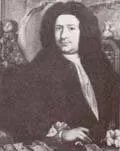Kilian Stobaeus
Dedicated scientist and researcher who taught Carl von Linné
Probably you have all seen the magnolia tree on the northwestern side of the fountain in front of the University building in Lund. But, have you ever noticed the statue of Kilian Stobaeus the Elder that is sitting among the rich leaves of that tree? Of the professors at Lund University, he is one of only a few that has been honoured with a statue at the university.
First in Sweden to receive a doctorate of medicine
Kilian Stobaeus (1690-1742) was born in Vinslöv into one of the oldest families associated with Lund University. Indeed, no less than five professors at this university have carried that name. After beginning his studies at the university, he became the student of the well-known professor Johan Jacob Döbelius. In 1721, Stobaeus was the first individual in Sweden to receive a doctorate of medicine. After serving as acting professor of medicine for some time, a professorship and chair in natural philosophy and experimental physics was created for him in 1728. In 1732, Stobaeus accepted a professorship in history.
Free medicine for the poor
In addition to his academic responsibilities, Stobaeus was also a devoted physician. In his private practice and laboratory he cared and provided free medicine for the poor and the sick. He is also responsible for popularizing Ramlösa spring as a health spa, which was originally founded by his earlier mentor Döbelius. Indeed, in his later years he took advantage of Ramlösa spring to treat his own ailments. He was apparently plagued with migraine and backache, among other things.
Interest in natural science and history
Stobaeus had a remarkably broad interest in all facets of natural science and history. His emphasis on observation and experience was critical in his scientific approach and was groundbreaking at the time. He collected numerous historical items including prehistoric coins and relics, and biological and geological specimens. These collections were used to establish museums of natural history, archeology, and history. The most well-known of these was "Museum Stobaeanum", which was founded in 1735 and donated by him to Lund University.
Many of the museum collections at Lund University that exist today contain his specimens and have served for studies by numerous later students in various disciplines.
Taught Carl von Linné
One student who developed a lifelong appreciation for these collections was Carl von Linné, known as Linnaeus before being ennobled (1707-1778), the most famous Swedish natural scientist and recognized internationally as the father of modern classification of flora and fauna.
Linnaeus grew up under poor conditions with parents who wanted him to become a clergyman primarily to secure his income. His schoolteachers, on the other hand, realized his limited abilities in Greek, theology, and eloquence, and thought him better suited for pursuing medicine. His father had established a flower garden with a considerable number of rare plants, and this garden absolutely fascinated Linnaeus already at a very early age. His mother frequently brought flowers from the garden to decorate his cradle thereby literally filling his childhood with flowers.
After entering university, it took only a short time before Linnaeus recognized Stobaeus' vast collections of biological specimens and natural science knowledge and before Stobaeus in turn recognized Linnaeaus' immense interest in these subjects. For Linnaeus this must have been a clear extension of what his parents had seeded in him during his childhood. This led to a lifelong bond between Stobaeus and Linnaeus, who appreciated Stobaeus by saying that he "...loved me, not as a pupil, but as if I were his son". Stobaeus broadened Linnaeus knowledge about biological specimens by teaching him how to treat and preserve them to facilitate their classification.
Stobaeus' role as father figure for Linnaeus extended even further. Linnaeus was poor and Stobaeus offered him both room and board and let him attend his classes for free. Linnaeus tells us that he secretly borrowed books from Stobaeus' well-equipped library, which contained about 1700 volumes, and read them in bed under the candlelight. This apparently terrified the mistress of the house, who thought Linnaeus accidentally would set the house on fire. On the other hand, Stobaeus recognized the young man's immense curiosity and, reasonably, let him use the library during the day and dine with him at night.
Linnaeus serves as only one of many examples of students that gained from the great intellect, teaching skills, and collections of Kilian Stobaeus. Indeed, their relationship reflects the deep and sincere teaching traditions that have always existed at the Faculty of Medicine at Lund University.
Text: Hülya Leeb-Lundberg
Kilian Stobaeus
